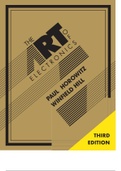O
F
THE S
IC
N
O
R
T
C I TZ
LE W
E O
R ILL
O
H DH
UL EL
A FI
P IN
W
THIRD
EDITION
,The Art of Electronics
Third Edition
At long last, here is the thoroughly revised and updated, and long-anticipated, third edition of the hugely successful
The Art of Electronics. Widely accepted as the best single authoritative text and reference on electronic circuit design,
both analog and digital, the first two editions were translated into eight languages, and sold more than a million copies
worldwide. The art of electronics is explained by stressing the methods actually used by circuit designers – a combination
of some basic laws, rules of thumb, and a nonmathematical treatment that encourages understanding why and how a
circuit works.
Paul Horowitz is a Research Professor of Physics and of Electrical Engineering at Harvard University, where in 1974
he originated the Laboratory Electronics course from which emerged The Art of Electronics. In addition to his work in
circuit design and electronic instrumentation, his research interests have included observational astrophysics, x-ray and
particle microscopy, and optical interferometry. He is one of the pioneers of the search for intelligent life beyond Earth
(SETI). He is the author of some 200 scientific articles and reports, has consulted widely for industry and government,
and is the designer of numerous scientific and photographic instruments.
Winfield Hill is by inclination an electronics circuit-design guru. After dropping out of the Chemical Physics graduate
program at Harvard University, and obtaining an E.E. degree, he began his engineering career at Harvard’s Electronics
Design Center. After 7 years of learning electronics at Harvard he founded Sea Data Corporation, where he spent 16 years
designing instruments for Physical Oceanography. In 1988 he was recruited by Edwin Land to join the Rowland Institute
for Science. The institute subsequently merged with Harvard University in 2003. As director of the institute’s Electronics
Engineering Lab he has designed some 500 scientific instruments. Recent interests include high-voltage RF (to 15 kV),
high-current pulsed electronics (to 1200 A), low-noise amplifiers (to sub-nV and pA), and MOSFET pulse generators.
,This page intentionally left blank
, THE ART OF ELECTRONICS
Third Edition
Paul Horowitz HARVARD UNIVERSITY
Winfield Hill ROWLAND INSTITUTE AT HARVARD
,32 Avenue of the Americas, New York, NY 10013-2473, USA
Cambridge University Press is part of the University of Cambridge.
It furthers the University’s mission by disseminating knowledge in the pursuit of
education, learning, and research at the highest international levels of excellence.
www.cambridge.org
Information on this title: www.cambridge.org/9780521809269
© Cambridge University Press, 1980, 1989, 2015
This publication is in copyright. Subject to statutory exception
and to the provisions of relevant collective licensing agreements,
no reproduction of any part may take place without the written
permission of Cambridge University Press.
First published 1980
Second edition 1989
Third edition 2015
7th printing 2016 with corrections
Printed in the United States of America
A catalog record for this publication is available from the British Library.
ISBN 978-0-521-80926-9 Hardback
Cambridge University Press has no responsibility for the persistence or
accuracy of URLs for external or third-party Internet websites referred to
in this publication and does not guarantee that any content on such
websites is, or will remain, accurate or appropriate.
,To Vida and Ava
,This page intentionally left blank
,In Memoriam: Jim Williams, 1948–2011
,This page intentionally left blank
, CONTENTS
List of Tables xxii 1.6.5 Regulators 34
1.6.6 Circuit applications of diodes 35
Preface to the First Edition xxv 1.6.7 Inductive loads and diode
protection 38
Preface to the Second Edition xxvii 1.6.8 Interlude: inductors as friends 39
1.7 Impedance and reactance 40
Preface to the Third Edition xxix 1.7.1 Frequency analysis of reactive
circuits 41
ONE: Foundations 1 1.7.2 Reactance of inductors 44
1.1 Introduction 1 1.7.3 Voltages and currents as
1.2 Voltage, current, and resistance 1 complex numbers 44
1.2.1 Voltage and current 1 1.7.4 Reactance of capacitors and
1.2.2 Relationship between voltage inductors 45
and current: resistors 3 1.7.5 Ohm’s law generalized 46
1.2.3 Voltage dividers 7 1.7.6 Power in reactive circuits 47
1.2.4 Voltage sources and current 1.7.7 Voltage dividers generalized 48
sources 8 1.7.8 RC highpass filters 48
1.2.5 Thévenin equivalent circuit 9 1.7.9 RC lowpass filters 50
1.2.6 Small-signal resistance 12 1.7.10 RC differentiators and
1.2.7 An example: “It’s too hot!” 13 integrators in the frequency
1.3 Signals 13 domain 51
1.3.1 Sinusoidal signals 14 1.7.11 Inductors versus capacitors 51
1.3.2 Signal amplitudes and decibels 14 1.7.12 Phasor diagrams 51
1.3.3 Other signals 15 1.7.13 “Poles” and decibels per octave 52
1.3.4 Logic levels 17 1.7.14 Resonant circuits 52
1.3.5 Signal sources 17 1.7.15 LC filters 54
1.4 Capacitors and ac circuits 18 1.7.16 Other capacitor applications 54
1.4.1 Capacitors 18 1.7.17 Thévenin’s theorem generalized 55
1.4.2 RC circuits: V and I versus time 21 1.8 Putting it all together – an AM radio 55
1.4.3 Differentiators 25 1.9 Other passive components 56
1.4.4 Integrators 26 1.9.1 Electromechanical devices:
1.4.5 Not quite perfect. . . 28 switches 56
1.5 Inductors and transformers 28 1.9.2 Electromechanical devices:
1.5.1 Inductors 28 relays 59
1.5.2 Transformers 30 1.9.3 Connectors 59
1.6 Diodes and diode circuits 31 1.9.4 Indicators 61
1.6.1 Diodes 31 1.9.5 Variable components 63
1.6.2 Rectification 31 1.10 A parting shot: confusing markings and
1.6.3 Power-supply filtering 32 itty-bitty components 64
1.6.4 Rectifier configurations for 1.10.1 Surface-mount technology: the
power supplies 33 joy and the pain 65
ix




